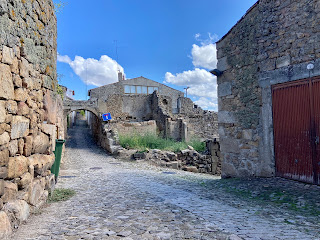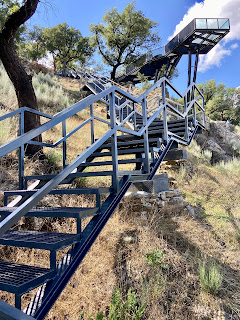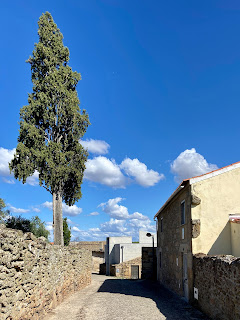One destination in Saramago's "Viagem" seems totally random: Cidadelhe (pop 40 in 2011). In the book, Saramago's traveller is having dinner in his hotel in Guarda, and the waiter, a fellow named José António Guerra, encourages a visit to his hometown. The waiter touchingly describes the town as "condemned" – ie, the population of the village is slowly declining to zero.
The traveller states, "Cidadelhe, calcanhar do mundo". The book translation is: "Cidadelhe really is at the ends of the earth". But "calcanhar do mundo" translates to "heel of the world". How could we go further than the heel of the world?
So from Alfaiates, we follow the Rio Côa north. First, a lunch-stop in Pinhel (pop 9,627 in 2011). The Igreja da Misericórdia (sixteenth century) is shut, but the Igreja Martriz (de São Luis, sixteenth century) is open. This offers a wonderful altar, though the rest of the church interior is quite plain. The altar features a paneled ceiling of painted portraits, much like the Igreja in Fundão. The images here are more subdued, though the elaborate framing in the barrel vault is studded with red diamonds and spiked at the joints.
Just past the pelourinho is the road to the Castelo (thirteenth century). The shaft of the pelourinho looks new, but the hollow cap and base look properly old.
Just to the right of the passage, behind the Casa dos Condes de Pinhel is one the restored bastions towers of the Murlaha de Pinhel. The steel stairs give access to the parapet, which creates a private pathway connecting many of the houses lining the walls – a relationship we have not witnessed til now. The inhabitants thus hang their laundry over the defensive walls, creating quite an incongruous visual.
We make our way up, first to the Torre de Relógio (nineteenth century) and then the Torre de Menagem, where there are excellent views into the valley.
After lunch, we take a quick photo stop just outside the castle walls, at the the ruined facade of the Igreja da Santíssima Trinidade (fourteenth century).
Our next stop is the Miradouro da Faia, a steel and glass deck overhanging the Vale de Côa, which opened just over a year ago. The ruined village of Azêvo forms an entry way; we wonder how the workers managed to get the steel and glass down this rough dirt road.
The floating glass 'cutout' in the deck shows off the bend in the Rio Côa. There is an upper deck and a lower deck. Near the lower deck, the bark of the cork trees looks to have been harvested. So many curiosities, but the lookout is truly breathtaking. The rough, scrabble surface of the Vale do Côa seems nearly unmarked by human intervention.
It's late afternoon when we finally arrive in the 'heel of the world', and it's surprisingly hot. The locals, obviously cognizant of the conditions, are all inside watching TV. Outside, the feral cats and barking dogs keep watch.
We park near the tiny Capela de São Sebastião (seventeenth century). The traveller is our guide:
Above the door in the porch protecting the entrance, there is a local mannerist painting depicting the Calvary. Although the porch keeps off the rain and the sun, it can do nothing about the wind and the cold, so it is a miracle the painting is so well preserved.The traveller went inside the chapel, and found himself face to face with the most extraordinary St Sebastian he had ever seen. It was obviously a recent creation, with bright pink colours freshly varnished, and the dark shadow of a beard. The saint has an arrow through his heart, and yet he is smiling. But what is extraordinary is the size of his ears, real fans, to use the popular Portuguese expression. The power of faith must indeed be great if believers can keep a straight face when confronted with this comical saint. And the proof of this great power is shown by the fact that four women are already praying inside the recently-opened chapel. And the only smile to be seen is that of the saint. (José Saramago, “Journey to Portugal,” 1990; trans Hopkinson-Caistor, 2000)


The traveller is delighted by some doorways that are sculpted or have decorative bas-reliefs: a bird settled on the head of a winged angel, between two animals that could be lions, dogs or wingless griffins, a tree spreading over two castles above a geometrical pattern offleurs-de-lys and garlands. (José Saramago, “Journey to Portugal,” 1990; trans Hopkinson-Caistor, 2000)
The Pálio de Cidadelhe (eighteenth century), which Saramago calls a "must-see" is housed in a shiny white show place called the Casa-Forte (opened in 2018), but the Casa is closed, with no posted hours.


So we arrive at the Igreja Matriz (eighteenth century) and it's lovely torre campanário (the 'Citizen' is on the left side of the stair arch, seventeenth century):
The traveller sees a small arch next to the church tower, with on one pillar the roughly sculpted figure of a man standing on a half-sphere. On the other pillar can be read in large letters: “The year 1656”. The traveller wants to know more and asks: “Who is this figure?” Nobody knows. For generations, the Citizen has belonged to Cidadelhe, he is a kind of lay patron saint, a tutelary god, fought over by the lower village (where the traveller is now) and As Eiras, the upper village, where the traveller first arrived. Apparently there was a time when the verbal disputes erupted into real fights, but historical sense prevailed in the end, because the Citizen has his roots at this end of the village. The traveller reflects on the strange love that links a village so lacking in material wealth to this badly sculpted, time-worn stone showing a human figure so roughly carved his arms are barely distinguishable, and becomes confused when he realises it is in fact easy to understand if we simply follow the essential paths, this stone, this man, this harsh landscape. He further reflects that one has to be careful in dealing with these simple things, one has to let them be and let them become what they may, not to push them, simply to be with them, and he looks again at this Citizen and at the happiness on the face of his new friend called José António Guerra, the man who has decided to keep all this in his memory. (José Saramago, “Journey to Portugal,” 1990; trans Hopkinson-Caistor, 2000)
This is how a journey should be. To pause, to look. The traveller’s face shows how moved he is. He leaves the church with José António Guerra, and climbs with him to the top of a hill that is the highest part of Cidadelhe. The birds are singing, the two men gaze out over the hills, taking in all there is to be seen from this vantage point. “I’ve liked it up here since I was a child,” his companion says. The traveller does not reply. He is thinking of his own childhood, of his mature years, of this village and other villages, and he wanders off. Each of them is in their own world, and with all this world. (José Saramago, “Journey to Portugal,” 1990; trans Hopkinson-Caistor, 2000)







































































No comments:
Post a Comment